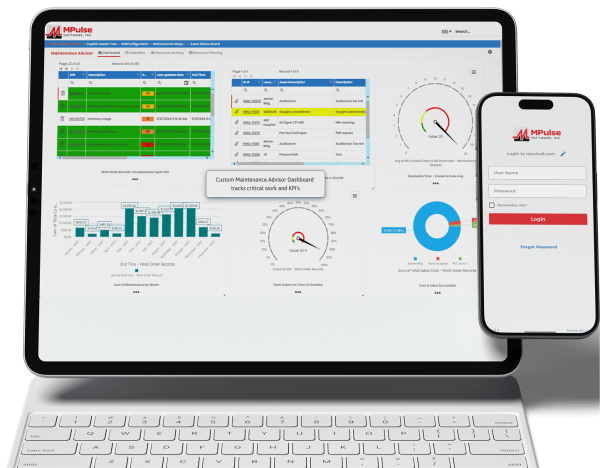Not all organizations are ready for predictive maintenance software.
However, some companies are.
If you’re one of them, then here’s how to do it the right way.
Table of Contents
Step 1: Get Your Stakeholders on the Same Page
The first step requires digging deep on the meaning of predictive maintenance before you get started. It will prevent a lot of confusion down the road, because people will define it differently.
Some people define predictive maintenance as the analysis of how long an asset will last using one or many types of measurement. A classic example is electrical transmission grids. Engineers analyze detailed information about equipment failure rates, so they can program software to predict when similar assets will fail in the future.
Others describe predictive maintenance as gathering data on the actual condition of equipment to determine when maintenance is needed. You might also hear it called condition-based maintenance (CBM). CBM tools and CMMS software can analyze how the asset is working—maybe by measuring operating temperature or oil viscosity, etc. This data helps spot signs of potential problems, and then CMMS software sends alerts before breakdowns occur.
CBM allows you to track meters and gauges on assets, and to trigger work orders at specific points. Because CBM monitors an asset’s real-time condition, there’s a predictive element to it (hence, the confusion).
Step 2: Identify Your Goals
Define your long-term goals for predictive maintenance solutions. Decide where they can translate into significant operational improvements for your organization. Some examples include…
- Less downtime
- Fewer repairs and lower repair costs
- Longer asset life
- A more comprehensive view of asset health for better maintenance planning
- The opportunity to use staff more effectively and efficiently by focusing them on the assets that really need attention
Pick one or two long-term goals, and then write down your questions about how predictive maintenance tools can help you get there. Also, determine the obstacles you’re facing. These questions can be general or specific, and they’ll serve as the basis for the next step.
Step 3: Create a Pilot Program
Select 1-5 assets to form a pilot predictive maintenance program. These assets should be key elements of your operations—ones that will have an impact on uptime, operations, and production. These assets should have conditions that can be monitored for performance, and any changes should be observable in the data to prevent failure.
Build predictive maintenance strategy around these assets first, investing in the right hardware and software to monitor the elements that you want to watch. Determine what sensors you’ll need to determine any changes to the condition of that asset, such as…
- Oil viscosity
- Vibration
- Radiography
- Motor circuit analysis
- Thermography
- Ultrasound
- Laser interferometry
- Electrical condition monitoring
- Electromagnetic measurement
Work closely with your CMMS vendor to integrate the data with your software to evaluate current conditions of critical assets and when failure may occur. Repeat these processes to improve your predictive maintenance program as you collect more data.
Step 3: Train Your Team
Training your team is so important, we’re including it as a separate step. Investing in predictive maintenance tools without training your people to use it is penny-wise and pound-foolish.
Different users will need to learn different things about the process. Management will need more information about data and reporting functions, whereas technicians need to focus on how predictive maintenance solutions can help with repairs. Some stakeholders may need more direction than others, so plan accordingly.
Training directly impacts your success—and your bottom line. It’s the real secret to predictive maintenance success.
Step 4: Start Asset Monitoring
Things are getting exciting now. Your sensors are working and sending data to the cloud. Your predictive maintenance software is analyzing this data and creating reports and insights. Now you should be able to…
- Monitor multiple meters (e.g., revolutions, psi, hours) on a single asset
- Specify multiple conditions, triggers, and responses
- Automatically generate work orders based on specified triggers
- Use data analysis tools to identify potential problems
- Set up automatic notifications
- Produce status reports and documents
Take time here to evaluate how things are going. Make changes as necessary. While you may be tempted to start expanding your predictive maintenance strategy rapidly, the long-term benefits of making improvements early will pay off later.
Step 5: Expand Your Predictive Maintenance Strategy
Now, you’re at the point where your predictive maintenance tools are running pretty smoothly. Start expanding it to other key assets by choosing another 1-5 and repeating the process. If you’ve done your due diligence, you’ll be able to expand more quickly now.
Establishing a predictive maintenance solution can feel overwhelming. But there’s no better source of valuable information than real-world experience. Also, take advantage of other people’s experience to make your own journey a little smoother.
You can start by calling our predictive maintenance technology experts at (800) 944-1796 (USA and Canada) or +1 (541) 302-6677 (outside of USA and Canada). We’re happy to share our secrets to success.
Planning your strategy for implementing predictive maintenance software can feel overwhelming, but MPulse is here to help. Contact us. We’ve worked with our customers, both large and small, to integrate predictive maintenance management technology in their maintenance operations. We’ll get you where you need to be at a pace that works for you.






